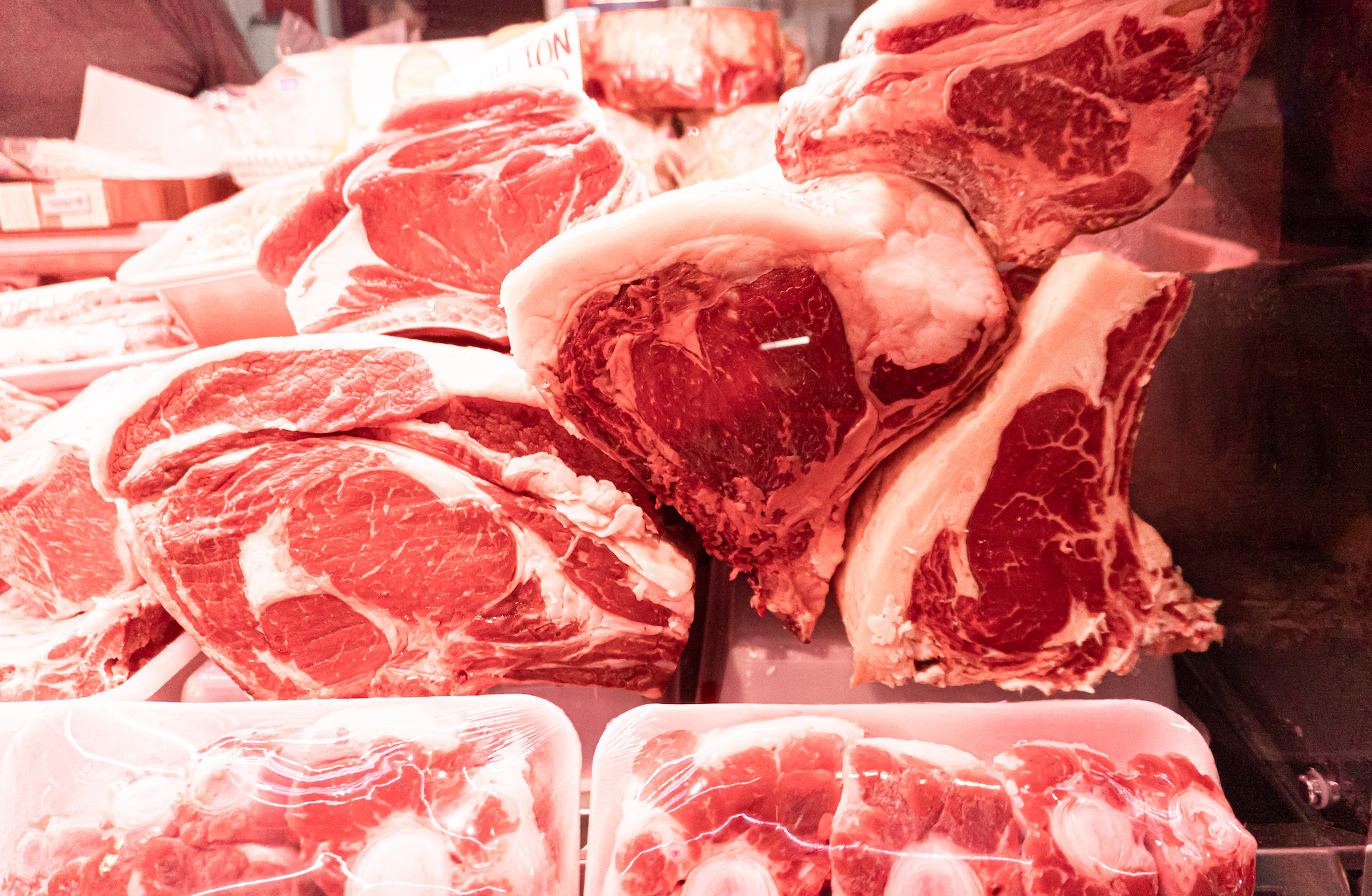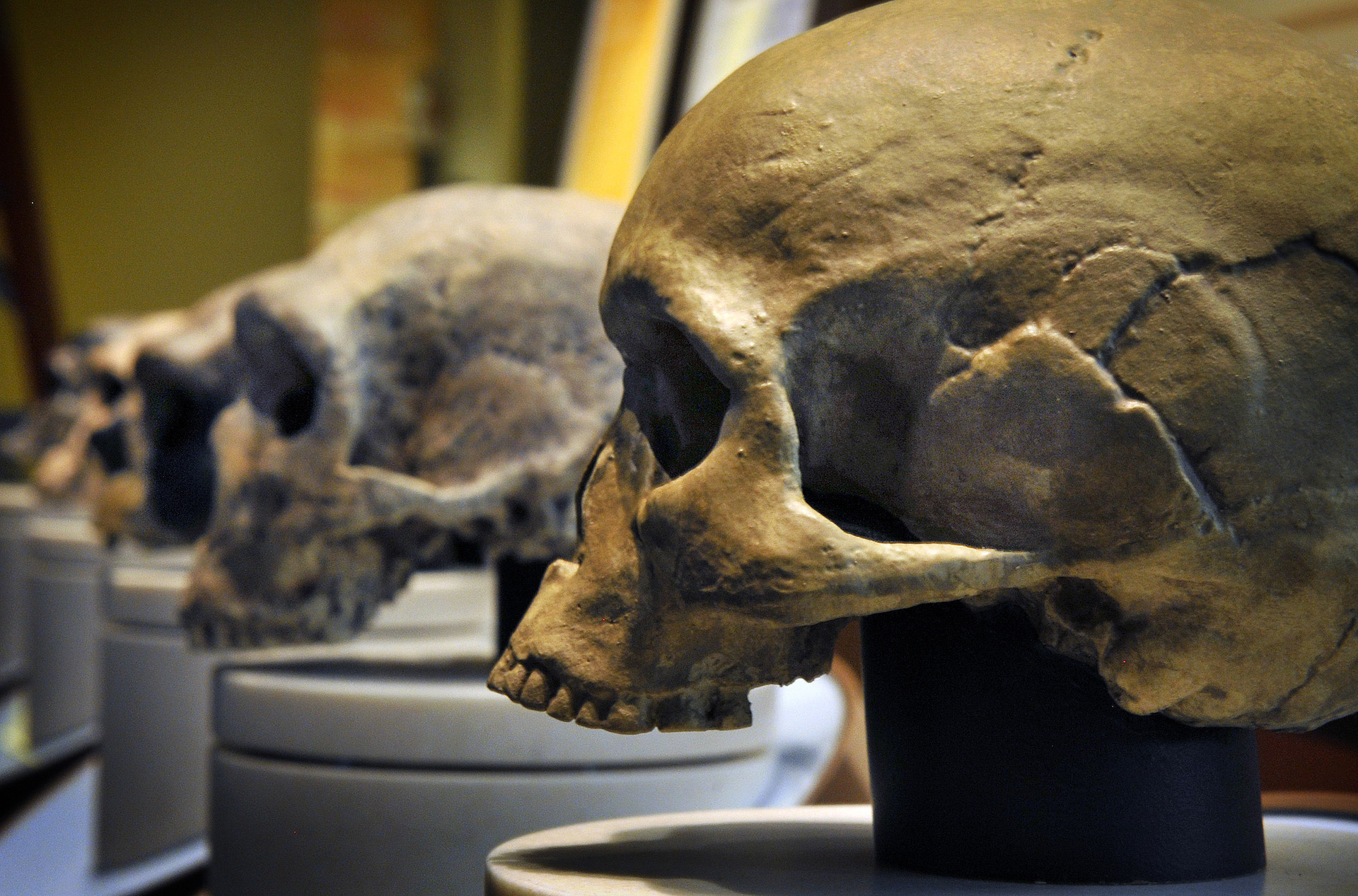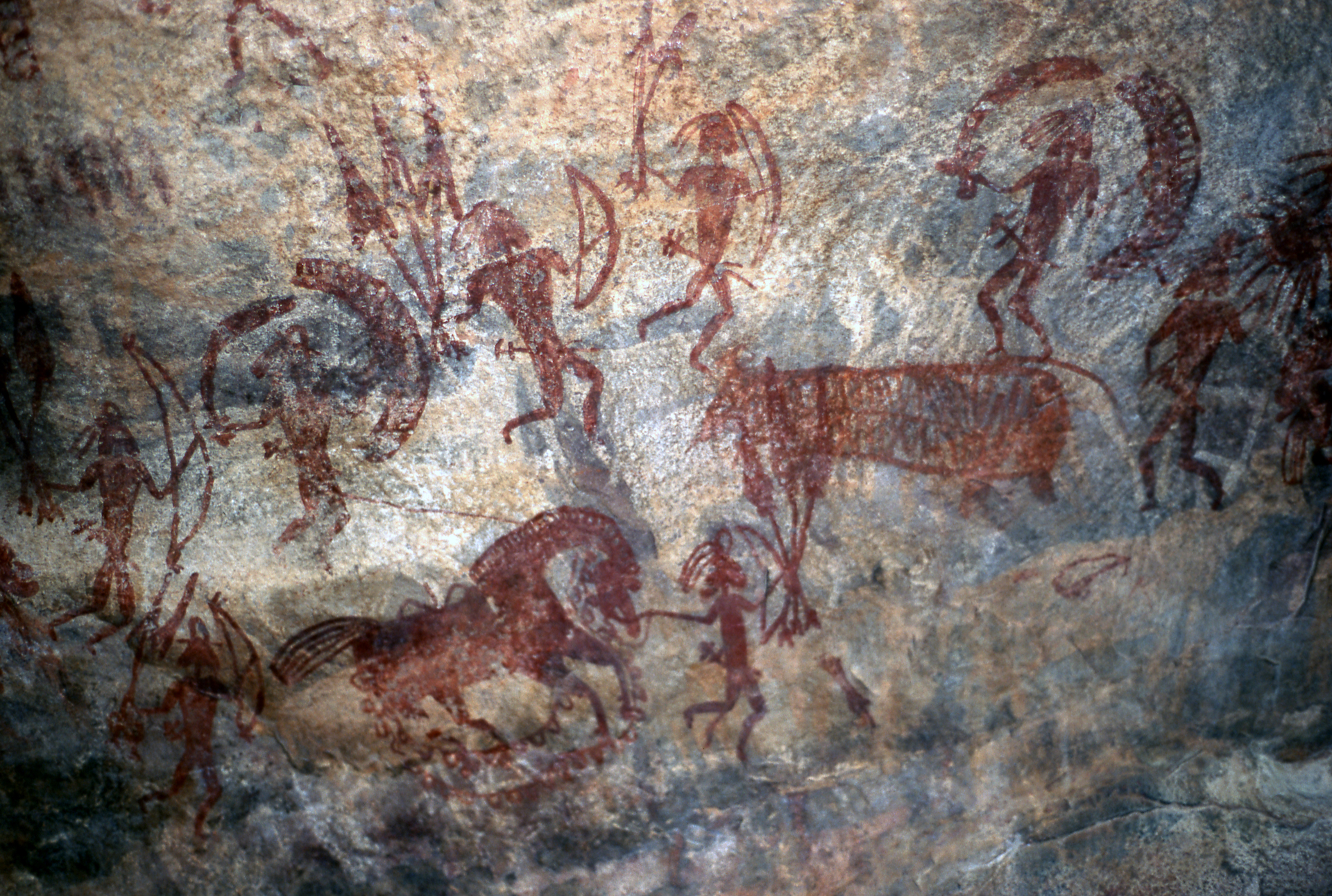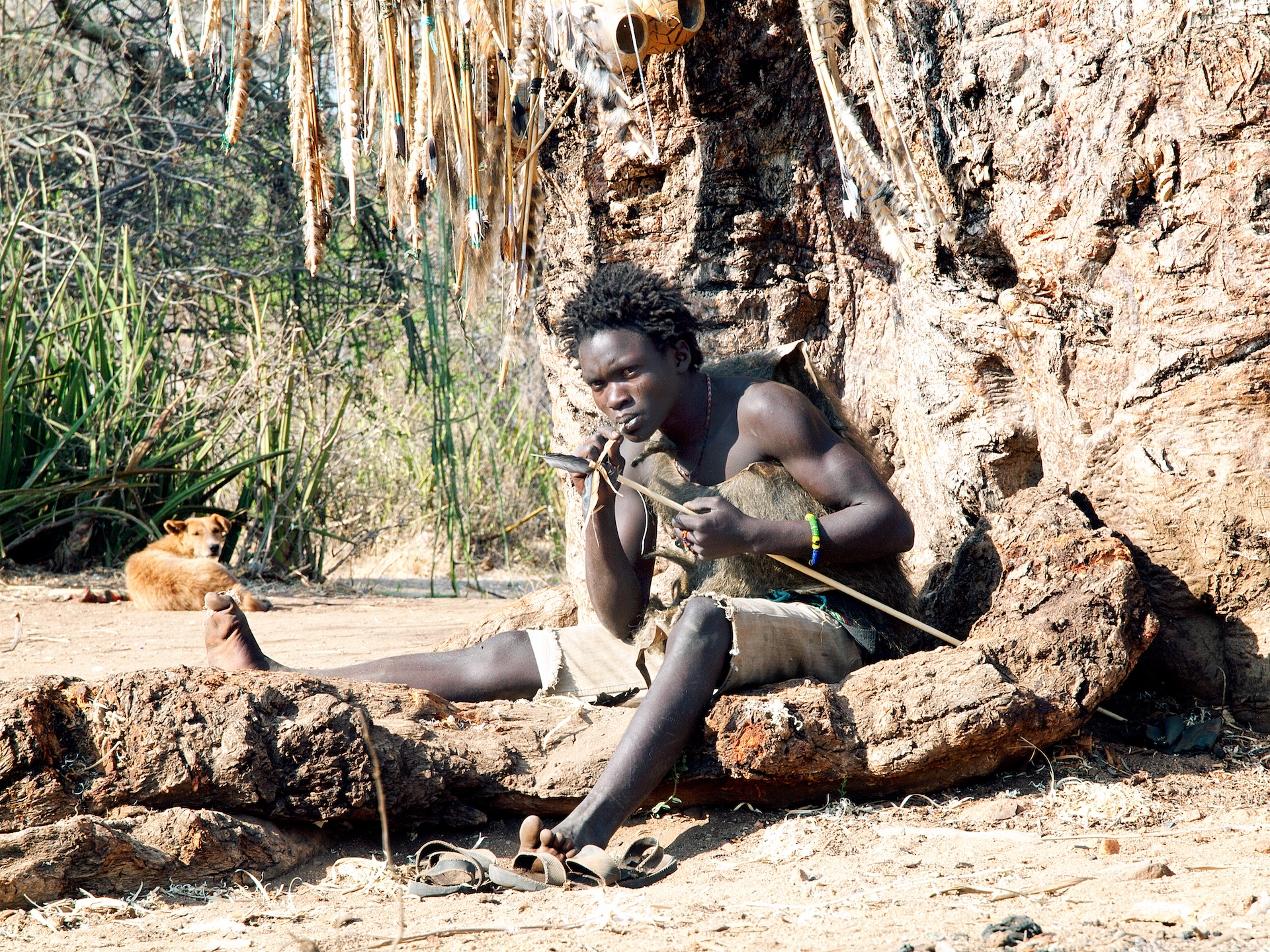
Paul Saladino is stripped to the waist, biceps bulging as he works a butcher's saw back and forth across a cow femur. When he finally severs the bone, a crowd of onlookers erupts in cheers. Flashing a smile, he checks to make sure he's being filmed, then scoops a spoonful of marrow from the center of one piece of bone. He then deposits it in the mouth of an eager young woman like a priest giving communion.
Saladino, a medical doctor, is a popular proponent of an animal-based diet that exalts meat and organs and demonizes vegetables. Through videos like this one on TikTok, as well as the podcast he hosts, he preaches the value of eating beef and liver, marrow and testicles to millions of followers on social media. He is the author of the 2020 book "The Carnivore Code" and a companion cookbook. He founded the company Heart and Soil, which sells organ-based supplements, and co-founded Lineage Provisions, which sells protein powder and meat sticks. Saladino contends that the traditional food pyramid, with its broad base of plant foods that narrows into animal foods, is upside down and that the medical establishment's view that high cholesterol causes heart disease is wrong. He says that meat and organs are the key to health, strength and vitality.
Saladino is not alone in his carnivorous pursuits. TikTok, Instagram and YouTube are teeming with influencers peddling meat-centric menus. Like the so-called paleo or caveman diets before them, these diets shun ultraprocessed foods such as potato chips, breakfast cereals, packaged breads, sodas and hot dogs. But they are significantly more restrictive than the paleo diet where plant foods are concerned. Some advocates, Saladino and celebrity adventurer Bear Grylls among them, allow for a limited amount of fruit but discourage vegetables, which they contend are loaded with defensive chemicals that are toxic to humans. Others, such as Canadian psychologist Jordan Peterson and his podcast host daughter, Mikhaila, champion a diet of beef, salt and water alone. Many, like social media personality Brian Johnson, aka Liver King, recommend consuming animal products — including dairy and eggs— raw.
Meatfluencers, as they are known, often characterize their regimens as "ancestral," made up of the foods our ancient predecessors ate. If this is what our ancestors ate, they argue, then this is what the human body is supposed to consume. "If you align your diet and lifestyle with millions of years of human and hominid evolution," Saladino says in another TikTok appearance, "that is how humans thrive."
Studies of the remains of our forebears, as well as observations of living primates and modern-day hunter-gatherers, refute the idea that humans evolved to subsist primarily on animals. Meat did play a significant role in our evolution. Yet that doesn't mean we're meant to eat like lions. Real ancestral human diets are difficult to reconstruct precisely, but they were vastly more varied than the mostly meat diets of carnivores, a finding that has important implications for what people today should eat to be healthy.

To be fair to the promoters of flesh-forward diets, scientists have traditionally paid a lot of attention to meat eating in human evolution, as have journalists who write about our origins (including me). Several factors have contributed to this trend. For one thing, we humans are unique among primates in regularly hunting animals that are as large as or larger than ourselves, and scientists are particularly interested in understanding traits that set us apart from other creatures. For another, stone tools and butchered animal bones are more readily preserved in the archaeological record than fragile plant remains. And then there's the fact that the hunting of animals — particularly large, dangerous mammals such as elephants — is inherently more exciting than the quiet business of gathering berries, nuts and tubers. In any case, it doesn't take a lot of googling to turn up a heap of scientific papers and popular articles touting the idea that hunting and eating meat made us human.
Interest in the role of meat and hunting in human origins has deep roots. Charles Darwin even speculated about its importance in his 1871 treatise, The Descent of Man, and Selection in Relation to Sex. Ideas about how carnivory shaped human evolution have shifted over the years, but the prevailing wisdom is this: around two million years ago Homo erectus, an early member of our genus, began evolving modern human body proportions, with longer legs, shorter arms, a smaller gut and a larger brain. The earliest stone tools and animal bones bearing cut marks date to before that period. The timing suggests that the invention of sharp-edged stone tools allowed early humans to butcher large animals and have access to a rich new source of calories. This nutritious food required less processing in the gastrointestinal tract, which allowed our energetically expensive gut tissue to shrink. Calorie-dense meat also provided fuel that allowed our energetically expensive brains to expand. A feedback loop took hold: as brains ballooned, our increasingly clever ancestors dreamed up ever more effective tools for procuring energy-rich animal foods, fueling more brain growth in Homo.

If that were all we knew about human evolution, it'd be tempting to conclude that we evolved to eat a meat-based diet. But that's only a piece of what anthropologists and archaeologists have learned about food and human origins, and even that chapter of our story has undergone revision over the past 15 years in light of new evidence. Fresh fossil discoveries and novel DNA analyses are revealing what our ancestors ate in unprecedented detail. For a clearer understanding of the evolution of humans and our diet, we need to take a closer look at what happened before and after that two-million-year mark.
Let's start at the beginning. Humans, monkeys and apes make up a subset of primates known as the higher primates, which evolved to eat fruit. The hominin lineage (Homo sapiens and its extinct relatives, including Ardipithecus, Australopithecus, and others) dates to roughly six million to seven million years ago. Fossils of the earliest known hominins indicate that they walked upright on two legs but still spent a lot of time in trees. They don't appear to have made stone tools and probably subsisted on a diet similar to that of chimpanzees and bonobos, our closest living relatives — which is to say mostly fruits, nuts, seeds, roots, flowers and leaves, along with insects and the occasional small mammal.
For the entire first half of our known history, hominins seem to have maintained this plant-based diet — they left no material trace of meat eating. It's not until nearly three million years after our lineage got its start that there's any evidence that they exploited large animals for food.
The oldest possible evidence of meat eating by hominins comes from Dikika, Ethiopia. There researchers found fragments of bone from goat- and cow-size mammals bearing marks suggestive of butchery that occurred at least 3.39 million years ago. The butcher, in this case, was probably Australopithecus afarensis, the small-brained, small-bodied hominin species to which the famous Lucy fossil belongs—the only hominin species known from this time and place. Although no tools were discovered, based on the pattern of damage to the bones, the researchers concluded that A. afarensis used sharp-edged stones to strip flesh from the bones and struck the bones with blunt stones to access the marrow inside.
The oldest stone tools come from the site of Lomekwi in northwest Kenya. Like the cut-marked bones from Dikika, these 3.3-million-year-old implements significantly predate the origin of our genus, Homo, and seem instead to be the handiwork of the small-brained australopiths. Both occurrences also appear to be isolated in time, a flash in the evolutionary pan, separated by the next oldest evidence for stone tools and butchery by hundreds of thousands of years.

It's only after two million years ago that hominins started to incorporate large game into their diet more routinely, according to Briana Pobiner, a paleoanthropologist at the Smithsonian National Museum of Natural History, who studies the evolution of meat eating in humans. The site of Kanjera South in southwestern Kenya, which records hominin activities from around two million years ago, is one of the earliest sites to preserve evidence of what researchers call persistent carnivory. There early members of Homo transported choice rocks from as many as 10 kilometers away to make their stone tools. They used these tools to extract meat and marrow from a variety of mammals that lived in the surrounding grasslands, from small antelopes to bovids the size of wildebeests. Some of the antelopes appear to have been acquired intact, presumably through hunting. The larger animals may have been scavenged. However they procured the carcasses, the Kanjera hominins butchered animals at this site repeatedly, over generations, the bones spanning a sediment layer three meters thick.
The hominins at Kanjera went back to this place again and again to butcher animals, but their pattern of persistent carnivory was not widespread elsewhere. Nor was it followed by a steady increase in meat eating over time, as would be expected in the feedback-loop scenario. W. Andrew Barr of George Washington University and his colleagues, including Pobiner, analyzed the evidence for hominin meat consumption in the zooarchaeological record of eastern Africa from between 2.6 million and 1.2 million years ago. Although the evidence for meat eating increases shortly after two million years ago with the debut of H. erectus, the first hominin to attain modern body proportions, the study found that this pattern is the result of a sampling bias: researchers have simply collected more archaeological material from this time period than from earlier intervals. Their findings, Barr, Pobiner and their co-authors concluded, did not support the hypothesis that meat made us human.
"When I think about changes in diet over time, I don't think the change was linear," Pobiner says. In many ways, the changes have been more about broadening the diet rather than progressing from vegetarian to meat eater, she explains. "Humans are omnivores," she says. "We've always been omnivores."
Even at Kanjera, with its impressive accumulation of butchered bones, meat wasn't the only food on offer. Analyses of the cutting edges of a sample of stone tools from the site revealed that most of the implements exhibit wear patterns characteristic of tools that have been used in experiments to chop herbaceous plants and their underground storage organs — those tubers, bulbs, roots and rhizomes that plants produce to store carbohydrates. A smaller proportion showed signs of animal-tissue processing.
“Humans are omnivores. We’ve always been omnivores.”
Briana Pobiner
As much as the evolution of meat eating is a focus of her work, Pobiner says, "that doesn't mean that I think that it was ever the most significant component of early human diets."
It's possible that early humans were targeting fat rather than meat when they first started butchering animals. Jessica Thompson of Yale University and her colleagues argue that before hominins invented stone tools suitable for hunting large animals, they may have used simpler implements to scavenge abandoned carcasses for their nutritious marrow and brains. Lean meat such as that from wild animals is energetically expensive to metabolize, and in the absence of fat in the diet, it can cause protein poisoning and other ills. Smashing scavenged bones to get to the marrow could have produced the extra nutrients needed to fuel brain growth before our ancestors developed the more complex technology needed for hunting.
The fat and meat of terrestrial mammals weren't the only possible source of extra calories for hungry hominins. Fish, shellfish, and other aquatic animals and plants sustained our forebears who lived near rivers, lakes and oceans. As early as 1.95 million years ago, Homo was exploiting fish and turtles, among other aquatic foods, in Kenya's Turkana Basin.
Our ancestors may have also wrung more calories from plant and animal foods by cooking them. Richard Wrangham of Harvard University has proposed that cooking, which makes food easier to chew and digest, may have provided Homo with the extra fuel needed to power a bigger brain. In 2022 researchers announced that they had found remains of fish that may have been cooked with controlled heat 780,000 years ago at the site of Gesher Benot Ya'aqov in Israel.
There is another place where scientists can look for clues to what early humans ate: their teeth. When researchers analyzed the tartar preserved in the stained teeth of two Australopithecus sediba individuals from South Africa, they found microscopic bits of silica from plants these hominins ate nearly two million years ago, including bark, leaves, sedges and grasses.

Even the Neandertals, our burly cousins who ruled Eurasia for hundreds of thousands of years and are known for having been skilled big-game hunters, consumed plants. Amanda Henry of Leiden University in the Netherlands and her colleagues found traces of legumes, dates and wild barley in the tartar on their fossilized teeth. And researchers led by Karen Hardy of the University of Glasgow discovered roasted starch granules in Neandertal teeth, indicating that they ate cooked vegetables. Some Neandertals might have even forgone animal flesh entirely: in a study co-led by Laura Weyrich of Pennsylvania State University, analyses of DNA preserved in the tartar of Neandertals found in El Sidrón cave in Spain turned up traces of pine nuts, moss and mushrooms — and no meat whatsoever.
Researchers have developed other techniques for studying what hominins put in their mouths and chewed, such as measuring the chemical isotopes in teeth, but these methods have important limitations: they can't determine the proportion of animal versus plant foods in the diet. To that end, another tartar study offers an inkling. James Fellows Yates of the Max Planck Institute for the Science of Human History and his colleagues analyzed DNA from bacteria preserved in Neandertal tartar and compared it with bacterial DNA from the teeth of modern chimps, gorillas, howler monkeys and modern humans. The team found that the Neandertals and modern humans in their sample had a group of Streptococcus bacteria in their mouths that the nonhuman primates didn't have. These strep bacteria eat sugars from starchy foods, such as roots, seeds and tubers. Their presence in the mouths of the Neandertals and modern humans — but not the nonhuman primates, which eat mostly nonstarchy plant parts — indicates that Homo had adapted to eating an abundance of starchy plant foods by the time Neandertals and modern humans split from their last common ancestor around 600,000 years ago. This timing hints that a high-carb diet helped to power brain expansion in Homo.
Other features of teeth suggest additional leads in the quest to understand what our ancestors ate. If you look at hominin tooth morphology over time, says paleoanthropologist and evolutionary biologist Peter Ungar of the University of Arkansas, you see that australopiths had big, flat teeth with thick enamel — traits that indicate they were specialized for crushing hard foods such as seeds. Homo, for its part, evolved smaller teeth with crests that were better suited to eating tough foods, including meat. Yet we obviously lack the long, sharp canine teeth that carnivores have for stabbing and tearing at prey and the sharp-edged carnassial teeth for shearing flesh.
"We're not pure carnivores, we never were," Ungar says. "Our teeth are not designed for meat eating." That doesn't mean we can't survive on animal tissue, he notes — cutting and cooking both make meat easier for us to consume — but "anybody who's chewed on beef jerky long enough knows that our teeth really aren't designed for that. Or, for that matter, raw steak."
The microscopic pits and scratches that foods leave on the teeth reinforce this message. Whereas Australopithecus microwear patterns reflect a narrow range of food types, early Homo shows a somewhat wider range. Later members of our genus show microwear texture patterns that indicate they ate even more kinds of foods. Although these lines of evidence are limited, Ungar says, they suggest Homo became a more versatile eater, capable of consuming a wider variety of foods than its predecessors. This versatility would have served our ancestors well as they spread into new environments with a greater diversity of food types on offer.

Proponents of animal-based diets are fond of pointing to the Hadza, a group of foragers in northern Tanzania, to make their case for going hard on meat. Saladino and Liver King name-check them regularly in their social media videos. "I can tell you very clearly that the Hadza don't give a shit about vegetables. They don't really eat vegetables," says Saladino, who once visited the Hadza on an excursion set up for tourists.
Anthropologists who have lived with the Hadza and studied their diet for years would disagree. Herman Pontzer of Duke University notes that for decades researchers have observed that plant foods make up at least 50% of the Hadza diet. The Hadza are not unique in this regard. Hunter-gatherers around the world get roughly half their calories from plant foods and half from animal foods on average. But that average obscures the real value of the hunting-and-gathering strategy, which is that it allows people to subsist on a wide variety of diets depending on what's available in their environment at a given time of year. Long-term studies of the Hadza show that some months they may get most of their calories from honey; other months they may eat mostly plant foods, including root vegetables. There are times they hardly eat any meat at all.
What made humans so triumphant wasn't that we swapped out plants for animals but that we added hunting to our repertoire. Hunting and gathering reliably produces more calories a day than any other primate strategy, Pontzer says. The reason it works is that it's a mixed portfolio. "You have some people going after high-value, hard-to-get animals with a lot of protein and fat, which is great," he says. "And you have people who are going after more dependable plant foods. It's the balance of those things that makes it so successful."
Hunting and gathering produces so many calories, in fact, that people can afford to share them with other group members, including children, whose brains take longer to develop than in other species and who need more time to learn how to fend for themselves. A strict plant eater can't do that, because although the number of calories one can get every day eating plants is very dependable, it might not be high enough to produce a surfeit of calories. A strict meat eater, on the other hand, will have long periods of famine between feasts that do not, on average, generate extra calories. But when we put those two things together, Pontzer observes, we generate a surplus. And that surplus, he surmises, is the variable that's made energetically expensive human things such as large brains and extended childhood possible.
What the fossil, archaeological and ethnographic evidence indicates, then, is that there is no one diet that nature prescribed for us. What our ancestors ate varied dramatically over time and space, driven in no small part by what was available to them as seasons changed, climate shifted, and populations spread into new ecosystems. Forged in that crucible of uncertainty, we evolved the ability to survive and thrive on an impressive diversity of foods. Hunter-gatherers around the world eat diets with wildly different proportions of plant and animal foods, and all of them appear to be healthy, protected from heart disease, diabetes, and other maladies that are common in industrial populations.
So what is a person looking to eat healthily supposed to do? "I think what it says is you should feel liberated to try a bunch of different diets and find one that works for you," Pontzer says. But "when somebody tells you that there's only one way to eat, they are wrong, and you can stop listening."
This article was first published at Scientific American. © ScientificAmerican.com. All rights reserved. Follow on TikTok and Instagram, X and Facebook.







